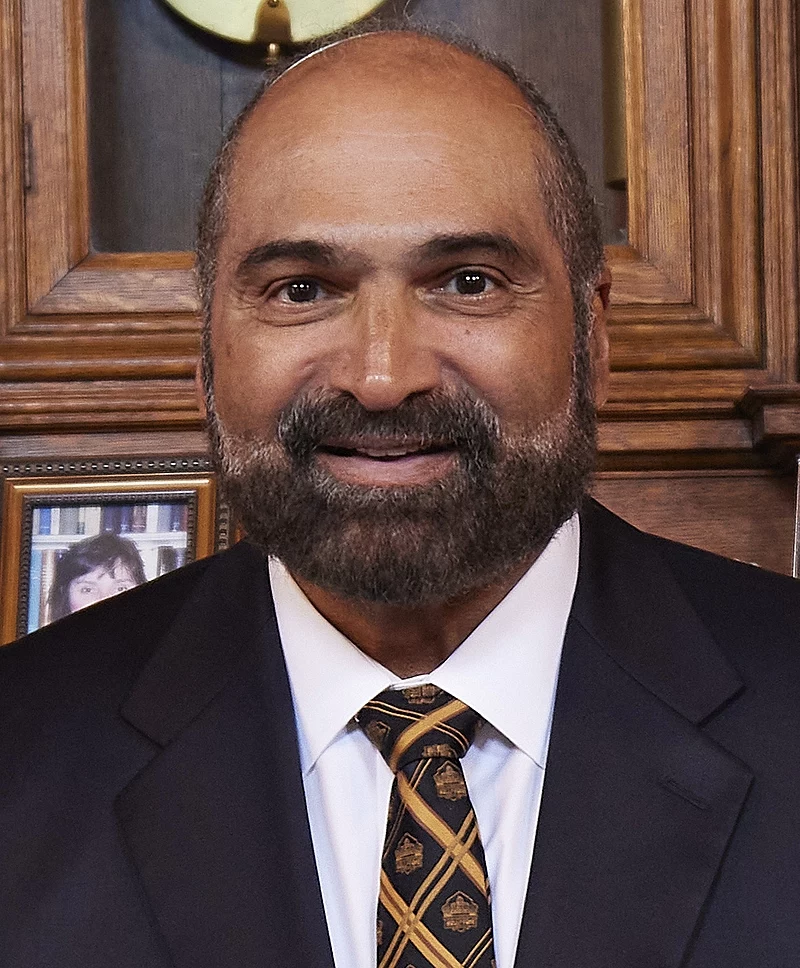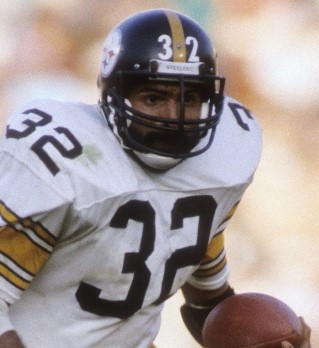
FROM WIKIPEDIA COMMONS
Franco Harris (March 7, 1950 – December 20, 2022) was an American professional football player who played running back in the National Football League (NFL) for 13 seasons, primarily for the Pittsburgh Steelers. He was a key player in one of professional football’s most famous plays, dubbed the “Immaculate Reception” by Pittsburgh sportscaster Myron Cope.
After playing college football for the Penn State Nittany Lions, he was selected by the Steelers in the first round of the 1972 NFL Draft, the 13th overall pick. He played his first 12 years in the NFL with the Steelers; his 13th and final year was spent with the Seahawks. He was inducted into the Pro Football Hall of Fame in 1990.
Harris died on December 20, 2022, three days before the 50th anniversary of the “Immaculate Reception”, at the age of 72. Harris’s death was considered sudden, as he had been active on social media just days before his death and had spoken to visitors at the Heinz History Center the day before his death. Harris’s death just days before the 50th anniversary of the Immaculate Reception and his subsequent jersey number retirement was immediately reminiscent of Pittsburgh Pirates legend Willie Stargell, who died on the same day as the official opening of PNC Park in 2001 and only two days following the unveiling of a bronze statue at PNC Park of Stargell.
PROFESSIONAL CAREER
In his first season with the Steelers (1972), Harris was named the league’s Rookie of the Year by both The Sporting News and United Press International. In that season he gained 1,055 yards on 188 carries, with a 5.6 yards per carry average. He also rushed for 10 touchdowns and caught four touchdown passes. He was popular with Pittsburgh’s large Italian-American population: his fans, including “Brigadier General” Frank Sinatra, dubbed themselves “Franco’s Italian Army” and wore army helmets with his number on them.
Harris was chosen for 9 consecutive Pro Bowls (1972–1980), and was All-Pro in 1977. Harris rushed for more than 1,000 yards in eight seasons, breaking a record set by Jim Brown. The running back tandem of Harris and Rocky Bleier combined with a strong defense to win four Super Bowls following the 1974, 1975, 1978, and 1979 seasons. On January 12, 1975, he was the Most Valuable Player of Super Bowl IX; in that game he rushed for 158 yards and a touchdown on 34 carries for a 16–6 win over the Minnesota Vikings. Harris was the first African American as well as the first Italian-American to be named Super Bowl MVP. Harris was a major contributor for the Steelers in all of their first four Super Bowl wins. His Super Bowl career totals of 101 carries for 354 yards are records and his four career rushing touchdowns are tied for the second-most in Super Bowl history.
Harris claimed that he extended his career and thus his contribution to the team’s objectives (including four Super Bowl victories) by avoiding unnecessary contact.
With the retirement of O. J. Simpson after the 1979 season, Harris became the career rushing leader among active players. Following the 1983 season, Harris and Walter Payton were both closing in on Jim Brown’s NFL rushing record, and Harris asked the Rooney family for a pay raise. Believing that Harris was on the downside of his career, they refused and Harris threatened to hold out. The Steelers released him during training camp in 1984 and he then signed with the Seattle Seahawks during the 1984 season. He played just eight games with the team, gaining only 170 yards before retiring (192 yards short of Jim Brown’s record).
In his 13 professional seasons, Harris gained 12,120 yards (then 3rd all-time) on 2,949 carries, a 4.1 yards per carry average, and scored 91 rushing touchdowns (then also 3rd). He caught 307 passes for 2,287 yards, a 7.4 yards per reception average, and nine receiving touchdowns. Harris’s 12,120 career rushing yards rank him 12th all time in the NFL, while his 91 career rushing touchdowns rank him 10th all time tied with Jerome Bettis.
Harris was a key player in one of professional football’s most famous plays, dubbed the “Immaculate Reception” by Pittsburgh sportscaster Myron Cope. In a 1972 playoff game, the Oakland Raiders were leading the Steelers 7–6 with 22 seconds to play when a Terry Bradshaw pass was deflected away from intended receiver John “Frenchy” Fuqua right as defender Jack Tatum arrived to tackle Fuqua. Harris snatched the ball just before it hit the ground and ran it into the endzone to win the game. The Raiders challenged the touchdown, claiming that Fuqua had handled the ball before Harris, which would invalidate the score because at that time it was against the rules for two offensive receivers to touch the ball. The Steelers maintained that the ball had touched Tatum instead. According to a recounting by the Pro Football Hall of Fame, the film of the play is inconclusive. Raiders linebacker Phil Villapiano attempted to criticize Harris’s achievement by stating that he was only in position to catch the ball because he was lazy, but replays show that Harris headed downfield when the Raiders forced Bradshaw out of the pocket, and can be clearly seen running before catching the deflected ball.
While the Steelers have only officially retired two uniform numbers, (Ernie Stautner‘s number 70 and Joe Greene‘s number 75), they have not reissued Harris’ number 32 since he left the team. In September 2022, the Steelers announced they would retire Harris’ number on December 24, 2022, at an event which will also celebrate the 50th anniversary of the “Immaculate Reception”.

In 1984, he received the Golden Plate Award of the American Academy of Achievement. In 1999, he was ranked number 83 on The Sporting News‘ list of the 100 Greatest Football Players. In 2006, The Heinz History Center, home of the Western Pennsylvania Sports Museum, installed a life-size figure of Harris in the grand concourse of Pittsburgh International Airport. The statue is a recreation of Harris’s “Immaculate Reception.” He was inducted into the New Jersey Hall of Fame in 2011.

